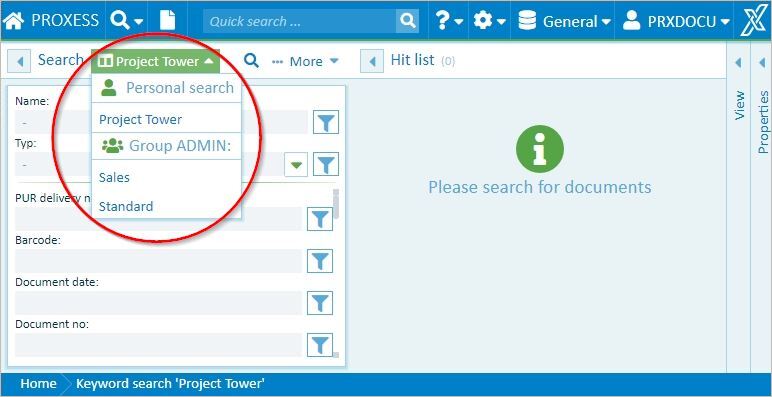
You can start the keyword search on the home page or via the Search menu.
For the keyword search, enter your search term or terms directly in the index fields. This allows you to search for documents quickly and efficiently. The more search terms you enter, the shorter your hitlist will be.

Fig.: Selection of the proper search mask
Depending on your user setting, a placeholder may be automatically added to your search term. (See: Settings (user))
By clicking the magnifying glass, you perform the search:
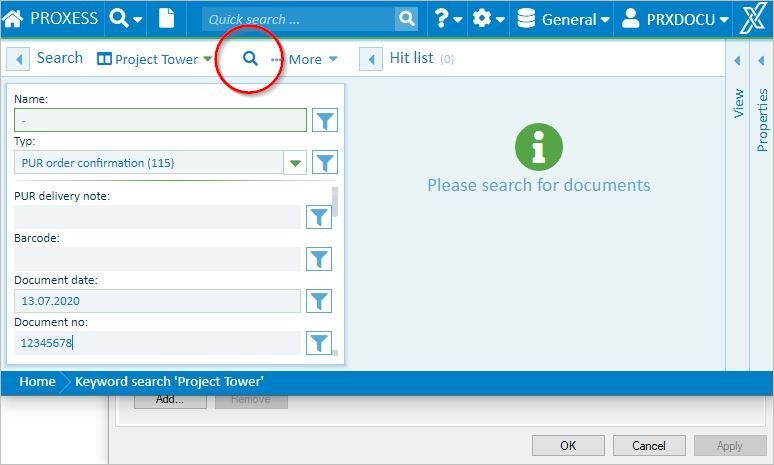
Fig.: Execute search
When you enter the search conditions, you are assisted by a range of functions:
The system automatically suggests search terms based on already archived documents.
Example:
If you enter the characters “Pro” in the name field, you will get a list of suggestions with all name entries starting with “Pro”.
The search term completion starts after the third character has been entered. It makes no difference whether you enter the characters in uppercase or lowercase letters.
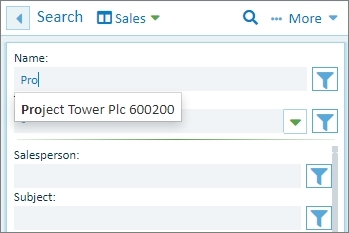
Fig.: Suggestions for automatic search term completion
An arrow symbol next to a search field indicates a saved list of terms from which you can choose an entry.
For the (document) type field, for example, there is always a fixed list of all stored document types.
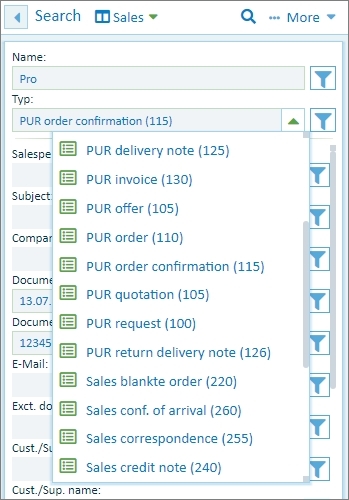
Fig.: List of all document types in the archive
Another option for the keyword search is to phrase the search condition with the help of the search wizard.
Next to each keyword field, you can find the ![]() symbol with which you can open the search wizard. The search wizard helps you enter the search term and shows the various options for specifying the search precisely. Select OK to enter your search condition in the field.
symbol with which you can open the search wizard. The search wizard helps you enter the search term and shows the various options for specifying the search precisely. Select OK to enter your search condition in the field.
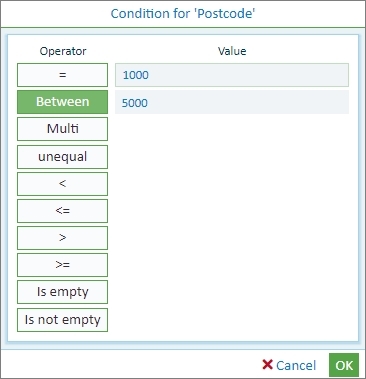
Fig.: Search wizard for the customer name field
|
Operator |
Optional syntax for direct field entry |
|
||
|
= |
= |
The entered search term must be spelled precisely. This takes into account the general user settings in which you can determine whether the entered search term is automatically written with or without the placeholder. |
||
|
between |
.. |
The searched field content must range from the lower to the upper value, inclusively. The BETWEEN operator can be used for text fields, date fields and number fields. Searching with a placeholder is not possible here.
Example: Search for all customers whose name starts with the letters “A” and “G”. The correct search entry must be: search BETWEEN “A” and “H”. Because “H” is the first entry after all customer names beginning with “G”.
|
||
|
multiple |
, |
An OR condition is used here. The search result shows all documents that contain at least one of the entered search terms. The search term and field content must be identical. Searching with a placeholder is not possible here. |
||
|
<> |
<> |
The searched field content must be unlike the entered value. |
||
|
< |
< |
The searched field content must be lower than the entered value. |
||
|
<= |
<= |
The searched field content must be lower than or equal to the entered value. |
||
|
> |
> |
The searched field content must be greater than the entered value. |
||
|
>= |
> |
The searched field content must be greater than or equal to the entered value. |
||
|
is empty |
IS_NULL |
Nothing should be entered in this field. |
||
|
is not empty |
IS_NOT_NULL |
This field may not be empty. |
Also see: Keyword search with the search wizard
If you have entered your search terms into the fields, you can start the search with the  magnifying glass.
magnifying glass.